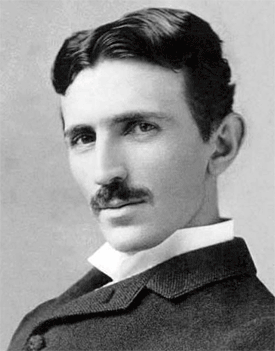Nikola
Tesla
In July of 1856, Nikola Tesla was born, in Yugoslavia. When he
was still a student in Graz, he became interested in building
a motor without a commutator. He made the original induction motors
in Strasbourg in 1883, and he worked in the Edison Laboratory
in the United States.
 Nikola Tesla
Nikola Tesla |
|
By 1885, Tesla had founded the "Tesla Arc Light Company"
based in New York. After this, he obtained the money and materials
that would be needed for his invention of induction motors with
high efficiency.
Tesla took out patents for his polyphase electric power transmission
system and his asynchronous motor in 1887. By 1891, he had taken
out 40 more patents in the same field. Niagara Falls' hydroelectric
power station used his method of polyphase power transmission,
when it was built.
Tesla began working in high frequency currents using generators,
and he would go on to invent a transformer for the purpose of
producing high frequency and high tension currents. This would
become known as "The Tesla Transformer". Tesla held
famous lectures, where he explained the impressive results he
had achieved in high frequency currents.
After a laboratory fire, Tesla had a new laboratory built, and
resumed his inspired work. He released new inventions from 1896
through 1914, and some of these are still used for information
by radio techs. Tesla discovered the system of four tuned circuits,
which became the basis of the understanding of radio transmissions.
He had a radio station constructed in Colorado just before 1900,
enabling him to apply his ideas and principles.
Radio control guidance was one of the next areas Tesla dealt
with. He built a ship model that was guided by radio signals,
and he had the patent on radio remote control of vehicles and
ships. This was the first base for wireless tele-mechanics.
Tesla has a permanent place in history, when it comes to modern
science. He was recognized around the world by other scientists,
and he had higher education degrees from many universities. Still,
he is often belittled when compared to Thomas
Edison, who worked in some of the same fields of study.
Nikola Tesla did very important work in various fields in science.
He published his own inventions in various lectures, and received
patents for many inventions during his life. He wrote for magazines
and newspapers, including articles about Alternating Current.
His patents included 25 in the field of electrical generators
and motors, and nine in the field of the transmission of electric
power.
Tesla published many technical and scientific articles, including
those pertaining to electric discharge, electric machines, high-frequency
currents, X-rays and even telephotography. He also expressed his
own personal ideas about electricity's future and the world, where
he discussed general and technical problems, which interest people
still.
Tesla had a keen interest in the development of X-rays. They
were not yet named when he began experimenting with them. He used
a vacuum tube, and peaks of electricity produced by his own Tesla
coil. He determined that the rays produced were minute particles,
and, years later, physicists would describe these particles as
photons.
Tesla even produced the first image from X-ray in the United
States, attempting to get an image of Mark Twain, a friend of
his, with his vacuum tube. Later, Tesla would obtain human body
images, which he referred to as shadowgraphs. He even commented
on what would be future benefits of X-rays, and future damages
of exposure to X-rays.
Rumor Has It …
Nikola Tesla electrified crowds one evening when he got up on
stage and combined the Moon Walk with sawing a lady in half. And
of course Nikola Tesla was not a magician. Ouch!
Written by Kevin Lepton
|

